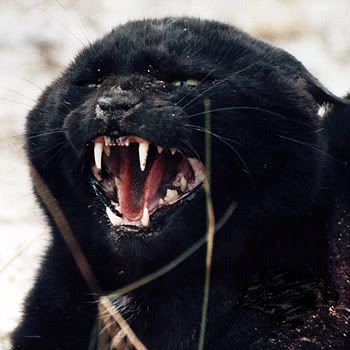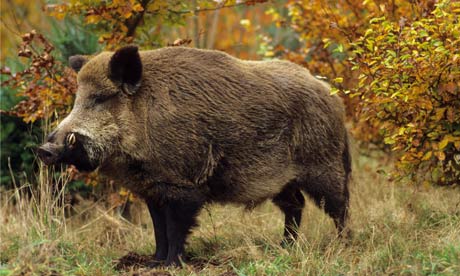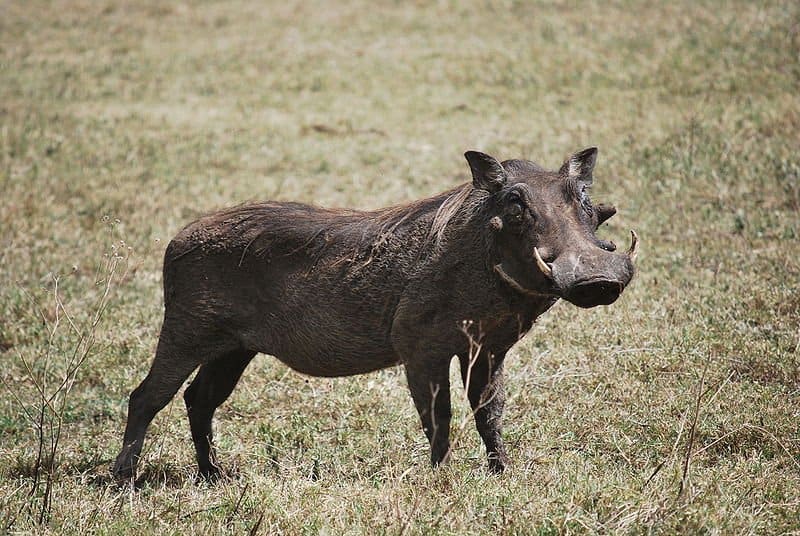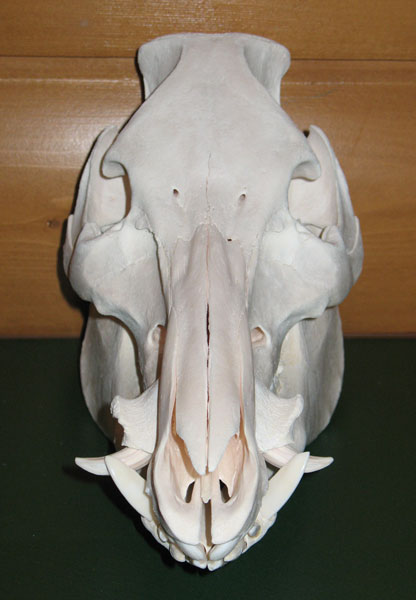Post by DinosaurMichael on Aug 15, 2012 20:21:23 GMT -5
Common Warthog - Phacochoerus africanus
The Warthog or Common Warthog (Phacochoerus africanus) is a wild member of the pig family that lives in grassland, savanna, and woodland in Sub-Saharan Africa. In the past it was commonly treated as a subspecies of P. aethiopicus, but today that scientific name is restricted to the Desert Warthog of northern Kenya, Somalia, and eastern Ethiopia. The common name comes from the four large wart-like protrusions found on the head of the warthog, which serve the purpose of defence when males fight as well as a fat reserve. Warthogs range in size from 0.91 to 1.5 m (3.0 to 4.9 ft) in length and 50 to 75 kg (110 to 170 lb) in weight. A warthog is identifiable by the two pairs of tusks protruding from the mouth and curving upwards. The lower pair, which is far shorter than the upper pair, becomes razor sharp by rubbing against the upper pair every time the mouth is opened and closed. The upper canine teeth can grow to 23 cm (9.1 in), and are of a squashed circle shape in cross section, almost rectangular, being about 4.5 cm (1.8 in) deep and 2.5 cm (0.98 in) wide. The tusk will curve 90 degrees or more from the root, and the tusk will not lie flat on a table, as it curves somewhat backwards as it grows. The tusks are used for digging, for combat with other hogs, and in defence against predators—the lower set can inflict severe wounds. Warthog ivory is taken from the constantly growing canine teeth. The tusks, more often the upper set, are worked much in the way of elephant tusks with all designs scaled down. Tusks are carved predominantly for the tourist trade in East and Southern Africa. The head of the warthog is large with a mane that goes down the spine to the middle of the back. There is sparse hair covering the body. Color is usually black or brown. Tails are long and end with a tuft of hair. Common warthogs do not have subcutaneous fat and the coat is sparse, making them suceptible to extreme environmental temperatures.

Wild Boar - Sus scrofa
Wild boar, also known as wild pig, (Sus scrofa) is a species of the pig genus Sus, part of the biological family Suidae. The species includes many subspecies. It is the wild ancestor of the domestic pig, an animal with which it freely hybridises. Wild boar are native across much of Northern and Central Europe, the Mediterranean Region (including North Africa's Atlas Mountains) and much of Asia as far south as Indonesia. Populations have also been artificially introduced in some parts of the world, most notably the Americas and Australasia, principally for hunting. Elsewhere, populations have also become established after escapes of wild boar from captivity. The term boar is used to denote an adult male of certain species — including, confusingly, domestic pigs. However, for wild boar, it applies to the whole species, including, for example, "wild boar sow" or "wild boar piglet". Wild boar are also known by various names, including wild hogs or simply boars. In North America they are more commonly referred to as razorbacks or European boars. The body of the wild boar is compact; the head is large, the legs relatively short. The fur consists of stiff bristles and usually finer fur. The colour usually varies from dark grey to black or brown, but there are great regional differences in colour; even whitish animals are known from central Asia. During winter the fur is much denser. Adult boars measure 90–200 cm (35–79 in) in length, not counting a tail of 15–40 cm (5.9–16 in), and have a shoulder height of 55–110 cm (22–43 in). As a whole, their average weight is 50–90 kg (110–200 pounds), though boars show a great deal of weight variation within their geographical ranges. In central Italy, their weight usually ranges from 80 to 100 kg (180 to 220 lb) while boars shot in Tuscany have been recorded to weigh up to 150 kg (331 lb). An unusually large French specimen shot in Negremont forest in Ardenne in 1999 weighed 227 kg (550 lb). Carpathian boars have been recorded to reach weights of 200 kg (441 lb). Romanian and Russian boars can reach weights of 300 kg (661 lb), while unconfirmed giants reported in early Russian hunting journals have reportedly weighed up to 320 kg (710 lb). Generally speaking, native Eurasian boars follow Bergmann's rule, with smaller boars nearer the tropics and larger, smaller-eared boars in the North of their range. Mature sows from Southeast Asia and southern India may weigh as little as 44 kg (97 lb). Adult males develop tusks, continuously growing teeth that protrude from the mouth, from their upper and lower canine teeth. These serve as weapons and tools. The upper tusks are bent upwards in males, and are regularly ground against the lower ones to produce sharp edges. The tusks normally measure about 6 cm (2.4 in), in exceptional cases even 12 cm (4.7 in). Females also have sharp canines, but they are smaller, and not protruding like the males' tusks. Wild boar piglets are coloured differently from adults, having marbled chocolate and cream stripes lengthwise over their bodies. The stripes fade by the time the piglet is about 6 months old, when the animal takes on the adult's grizzled grey or brown colour.

The Warthog or Common Warthog (Phacochoerus africanus) is a wild member of the pig family that lives in grassland, savanna, and woodland in Sub-Saharan Africa. In the past it was commonly treated as a subspecies of P. aethiopicus, but today that scientific name is restricted to the Desert Warthog of northern Kenya, Somalia, and eastern Ethiopia. The common name comes from the four large wart-like protrusions found on the head of the warthog, which serve the purpose of defence when males fight as well as a fat reserve. Warthogs range in size from 0.91 to 1.5 m (3.0 to 4.9 ft) in length and 50 to 75 kg (110 to 170 lb) in weight. A warthog is identifiable by the two pairs of tusks protruding from the mouth and curving upwards. The lower pair, which is far shorter than the upper pair, becomes razor sharp by rubbing against the upper pair every time the mouth is opened and closed. The upper canine teeth can grow to 23 cm (9.1 in), and are of a squashed circle shape in cross section, almost rectangular, being about 4.5 cm (1.8 in) deep and 2.5 cm (0.98 in) wide. The tusk will curve 90 degrees or more from the root, and the tusk will not lie flat on a table, as it curves somewhat backwards as it grows. The tusks are used for digging, for combat with other hogs, and in defence against predators—the lower set can inflict severe wounds. Warthog ivory is taken from the constantly growing canine teeth. The tusks, more often the upper set, are worked much in the way of elephant tusks with all designs scaled down. Tusks are carved predominantly for the tourist trade in East and Southern Africa. The head of the warthog is large with a mane that goes down the spine to the middle of the back. There is sparse hair covering the body. Color is usually black or brown. Tails are long and end with a tuft of hair. Common warthogs do not have subcutaneous fat and the coat is sparse, making them suceptible to extreme environmental temperatures.

Wild Boar - Sus scrofa
Wild boar, also known as wild pig, (Sus scrofa) is a species of the pig genus Sus, part of the biological family Suidae. The species includes many subspecies. It is the wild ancestor of the domestic pig, an animal with which it freely hybridises. Wild boar are native across much of Northern and Central Europe, the Mediterranean Region (including North Africa's Atlas Mountains) and much of Asia as far south as Indonesia. Populations have also been artificially introduced in some parts of the world, most notably the Americas and Australasia, principally for hunting. Elsewhere, populations have also become established after escapes of wild boar from captivity. The term boar is used to denote an adult male of certain species — including, confusingly, domestic pigs. However, for wild boar, it applies to the whole species, including, for example, "wild boar sow" or "wild boar piglet". Wild boar are also known by various names, including wild hogs or simply boars. In North America they are more commonly referred to as razorbacks or European boars. The body of the wild boar is compact; the head is large, the legs relatively short. The fur consists of stiff bristles and usually finer fur. The colour usually varies from dark grey to black or brown, but there are great regional differences in colour; even whitish animals are known from central Asia. During winter the fur is much denser. Adult boars measure 90–200 cm (35–79 in) in length, not counting a tail of 15–40 cm (5.9–16 in), and have a shoulder height of 55–110 cm (22–43 in). As a whole, their average weight is 50–90 kg (110–200 pounds), though boars show a great deal of weight variation within their geographical ranges. In central Italy, their weight usually ranges from 80 to 100 kg (180 to 220 lb) while boars shot in Tuscany have been recorded to weigh up to 150 kg (331 lb). An unusually large French specimen shot in Negremont forest in Ardenne in 1999 weighed 227 kg (550 lb). Carpathian boars have been recorded to reach weights of 200 kg (441 lb). Romanian and Russian boars can reach weights of 300 kg (661 lb), while unconfirmed giants reported in early Russian hunting journals have reportedly weighed up to 320 kg (710 lb). Generally speaking, native Eurasian boars follow Bergmann's rule, with smaller boars nearer the tropics and larger, smaller-eared boars in the North of their range. Mature sows from Southeast Asia and southern India may weigh as little as 44 kg (97 lb). Adult males develop tusks, continuously growing teeth that protrude from the mouth, from their upper and lower canine teeth. These serve as weapons and tools. The upper tusks are bent upwards in males, and are regularly ground against the lower ones to produce sharp edges. The tusks normally measure about 6 cm (2.4 in), in exceptional cases even 12 cm (4.7 in). Females also have sharp canines, but they are smaller, and not protruding like the males' tusks. Wild boar piglets are coloured differently from adults, having marbled chocolate and cream stripes lengthwise over their bodies. The stripes fade by the time the piglet is about 6 months old, when the animal takes on the adult's grizzled grey or brown colour.











